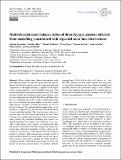Files in this item
Multi-decadal mass balance series of three Kyrgyz glaciers inferred from modelling constrained with repeated snow line observations
Item metadata
| dc.contributor.author | Barandun, Martina | |
| dc.contributor.author | Huss, Matthias | |
| dc.contributor.author | Usubaliev, Ryskul | |
| dc.contributor.author | Azisov, Erlan | |
| dc.contributor.author | Berthier, Etienne | |
| dc.contributor.author | Kääb, Andreas | |
| dc.contributor.author | Bolch, Tobias | |
| dc.contributor.author | Hoelzle, Martin | |
| dc.date.accessioned | 2019-03-13T12:30:10Z | |
| dc.date.available | 2019-03-13T12:30:10Z | |
| dc.date.issued | 2018-06-06 | |
| dc.identifier | 258134968 | |
| dc.identifier | 769d3baa-ed43-4614-9917-08a2ecfe21c3 | |
| dc.identifier | 85048216064 | |
| dc.identifier.citation | Barandun , M , Huss , M , Usubaliev , R , Azisov , E , Berthier , E , Kääb , A , Bolch , T & Hoelzle , M 2018 , ' Multi-decadal mass balance series of three Kyrgyz glaciers inferred from modelling constrained with repeated snow line observations ' , The Cryosphere , vol. 12 , no. 6 , pp. 1899-1919 . https://doi.org/10.5194/tc-12-1899-2018 | en |
| dc.identifier.issn | 1994-0416 | |
| dc.identifier.other | ORCID: /0000-0002-8201-5059/work/55379120 | |
| dc.identifier.uri | https://hdl.handle.net/10023/17265 | |
| dc.description.abstract | Glacier surface mass balance observations in the Tien Shan and Pamir are relatively sparse and often discontinuous. Nevertheless, glaciers are one of the most important components of the high-mountain cryosphere in the region as they strongly influence water availability in the arid, continental and intensely populated downstream areas. This study provides reliable and continuous surface mass balance series for selected glaciers located in the Tien Shan and Pamir-Alay. By cross-validating the results of three independent methods, we reconstructed the mass balance of the three benchmark glaciers, Abramov, Golubin and Glacier no. 354 for the past 2 decades. By applying different approaches, it was possible to compensate for the limitations and shortcomings of each individual method. This study proposes the use of transient snow line observations throughout the melt season obtained from satellite optical imagery and terrestrial automatic cameras. By combining modelling with remotely acquired information on summer snow depletion, it was possible to infer glacier mass changes for unmeasured years. The model is initialized with daily temperature and precipitation data collected at automatic weather stations in the vicinity of the glacier or with adjusted data from climate reanalysis products. Multi-annual mass changes based on high-resolution digital elevation models and in situ glaciological surveys were used to validate the results for the investigated glaciers. Substantial surface mass loss was confirmed for the three studied glaciers by all three methods, ranging from -0.30±0.19 to -0.41±0.33mw.e. yr-1 over the 2004-2016 period. Our results indicate that integration of snow line observations into mass balance modelling significantly narrows the uncertainty ranges of the estimates. Hence, this highlights the potential of the methodology for application to unmonitored glaciers at larger scales for which no direct measurements are available. | |
| dc.format.extent | 21 | |
| dc.format.extent | 7250556 | |
| dc.language.iso | eng | |
| dc.relation.ispartof | The Cryosphere | en |
| dc.subject | Water Science and Technology | en |
| dc.subject | Earth-Surface Processes | en |
| dc.subject | 3rd-DAS | en |
| dc.subject | SDG 15 - Life on Land | en |
| dc.title | Multi-decadal mass balance series of three Kyrgyz glaciers inferred from modelling constrained with repeated snow line observations | en |
| dc.type | Journal article | en |
| dc.contributor.institution | University of St Andrews. School of Geography & Sustainable Development | en |
| dc.contributor.institution | University of St Andrews. Bell-Edwards Geographic Data Institute | en |
| dc.identifier.doi | https://doi.org/10.5194/tc-12-1899-2018 | |
| dc.description.status | Peer reviewed | en |
This item appears in the following Collection(s)
Items in the St Andrews Research Repository are protected by copyright, with all rights reserved, unless otherwise indicated.

